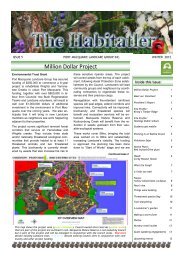Get the Latest information on fighting weeds - Port Macquarie ...
Get the Latest information on fighting weeds - Port Macquarie ...
Get the Latest information on fighting weeds - Port Macquarie ...
Create successful ePaper yourself
Turn your PDF publications into a flip-book with our unique Google optimized e-Paper software.
Bridal Creeper Asparagus asparagoides (syn. Myrsiphyllum asparagoides)<br />
FAMILY:<br />
ORIGIN: South Africa<br />
Noxious Weed Category: Class 4 and a Weed of Nati<strong>on</strong>al Significance (WoNS)<br />
Descripti<strong>on</strong><br />
Habit:. Bridal Creeper is a wiry climber (stems <strong>on</strong>ly 1-2mm wide) and up to 3m l<strong>on</strong>g. Leaves reduced to<br />
scales.. Leaves: Its fern-like or leaf-like stems are small and lance-shaped to 3cm l<strong>on</strong>g. Flowers: Sprays of<br />
sweet smelling white to pink flowers. Each petal has a distinctive central green stripe. Fruit: Fruit is a small<br />
red to black berry. Roots: <str<strong>on</strong>g>the</str<strong>on</strong>g> root system is a complex of white starch and water-storing tubers attached to<br />
a horny flat crown. These robust fleshy masses crowd out all o<str<strong>on</strong>g>the</str<strong>on</strong>g>r roots down to a depth of 10-15cm.<br />
Ecology<br />
Drought and shade tolerant, but will live in full sun and full shade. Clumps spread vegetatively and<br />
outcompete native ground covers (including seedlings of canopy trees, shrubs and vines). A water-hogging<br />
weed capable of killing mature trees presumably through dehydrati<strong>on</strong>. Occupies both sands (hind-dunes)<br />
and clay soils in open forest to rainforest. Bridal Creeper is a massive problem in sou<str<strong>on</strong>g>the</str<strong>on</strong>g>rn states of<br />
Australia, but recent biological c<strong>on</strong>trols have had a significant impact in high infestati<strong>on</strong> z<strong>on</strong>es.<br />
Dispersal<br />
Escaped from garden sites (through dumping). The attractive berries are widely dispersed by birds.<br />
C<strong>on</strong>trol<br />
HAND: this species is best removed manually by cutting away stems and carefully bag all berries.<br />
Crowning requires tracing to current growing tip of root mass which is lateral ra<str<strong>on</strong>g>the</str<strong>on</strong>g>r than upper (as in most<br />
o<str<strong>on</strong>g>the</str<strong>on</strong>g>r asparagus species).<br />
Immature fruit (L), Mature fruit and yellowing leaves at end of growing seas<strong>on</strong> (R)<br />
Photos: Ku-ring-gai Council<br />
Native look-a-like:<br />
Wombat Berry Eustrephus latifolius



